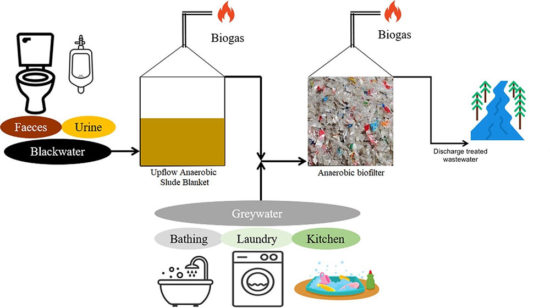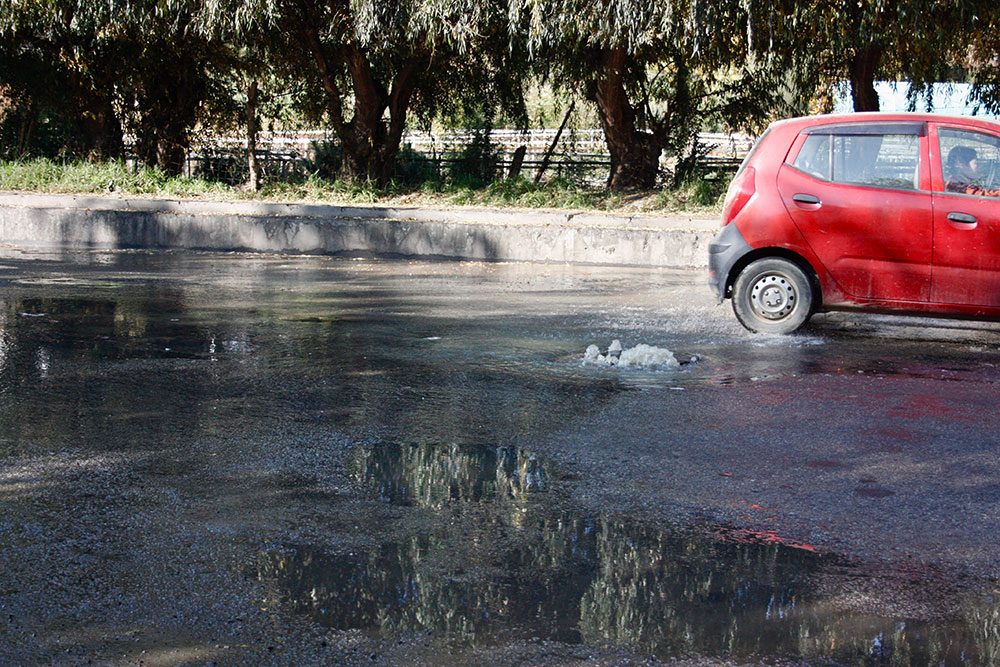Sewer in a few urban areas in Bhutan is collected through reticulated sewer systems and treated in bulk quantities using wastewater treatment ponds like the wastewater stabilization ponds (WSP) at Babesa. In absence of centralized reticulated sewer systems, an on-site sewage system referred to as a septic tank system has been used as an alternative option to reduce the impacts of releasing untreated black and grey water from the residential and commercial areas.

A recent study from Bhutan by Dorji et al. (2020) found that more than 80% of the urban population in Bhutan relies on the on-site sanitation system. Such on-site systems consist of a conventional septic tank and a soak pit system. Often the soak pits were missing, given the limited space in urban Bhutan. The discharge of septic tanks directly into the natural environment is a also common sight in many places across Bhutan.
Sewage discharge contains nutrients, metals, salts, hormonal disrupting chemicals, bacteria, viruses, and other pathogens. If not adequately treated through appropriately operated and maintained reticulated or on-site sewage systems, these affect water quality and can result in water contamination, and adverse impacts on public health and wildlife.
It is almost impossible to have 100% of the population connected to a centralized reticulated sewer system. Thus, exploring improvement in the current design of an on-site septic system is critical to prevent future health, environmental, and amenity issues. In some ‘developed’ countries an ‘Infill Sewerage Program is being implemented to rehabilitate the sites contaminated by septic tanks. Such a program requires a long process to recover and often comes with huge financial implications. Such future challenges could be avoided for Bhutan if an existing on-site septic system could be improved.
The article is aimed at investigating alternative on-site sanitation systems in the unsewered urban regions in accordance with the National Hygiene and Sanitation Policy 2020. A new on-site design should be able to function within the limited space limitations, which are often not sufficiently addressed by the current sanitation policy. Further, according to the building codes of Bhutan (2002), standard sizes for the building of septic tanks and soak pits are required in order to regulate urban wastewater management. However, the standard currently mentions only blackwater produced by toilets; the greywater produced by bathrooms and kitchens is not adequately covered. Additionally, the national guidelines for the design and development of human settlements (2013) place a strong emphasis on centralized wastewater treatment systems and do not consider ‘improving’ on-site sanitation systems.
Furthermore, there is enough evidence that Bhutan’s current on-site sanitation systems are working as intended or that they are suitable for the current urban environment. The national environmental standard for effluent discharge, only applies to effluents from centralized wastewater treatment facilities, while effluent discharge from on-site septic systems is rarely monitored. Thus, the extent of risk to public health from ill-managed septic tank systems and the environment is currently unknown.
According to the Bhutan Schedule of Rates (BSR) (MoWHS, 2018), the cost of an on-site sanitation system (15 users septic tank with soak pit) is US$ 483-559 (BTN 30,888-35,769), which equates to around US$ 32-37 (BTN 2,059-2,385) per population equivalent (PE). With the exception of the wastewater stabilization ponds system for Phuentsholing (BTN 1,574 PE) and Gelephu (BTN 20,000 PE), the unit cost per PE of on-site sanitation is significantly lower (BTN 747 PE) than the centralized wastewater treatment plants (BTN 2,672-20,000 PE). If network costs are taken into account, the unit cost of the centralized system is even much higher. The financial analysis stated above indicates that on-site sanitation systems are significantly less expensive than centralized reticulated sewerage systems.
An alternative low-cost technique that does not rely on soak pits or land disposal inside the plot area, but provides effluent quality sufficiently suitable for disposal in the environment could possibly be designed to replace the current on-site treatment systems. This could involve treating the blackwater that was separated at the source on-site with a chemical oxygen demand (COD) removal exceeding 70%, such as utilizing an anaerobic digester as a modified septic tank, followed by an anaerobic biofilter, as shown in the pictorial representation. Further, an Upflow Anaerobic Sludge Blanket (UASB) reactor procedure can replace traditional septic tanks to treat simply blackwater from the toilets, or both blackwater and greywater together, but the former is more efficient. The UASB, which has a COD elimination effectiveness of up to 80% or more, can be significantly more beneficial than a septic tank. By including an Anaerobic Biofilter (ABF) or connected growth as a post-treatment unit to UASB, the treatment effectiveness is further boosted.
Thus, a way forward into an in-depth exploration of alternative improved on-site systems should include:
1. Investigating new technological alternatives like UASB to replace the outdated septic tank and soak-pit system for better on-site wastewater treatment at the individual household level through the promotion of the best available technologies.
2. Explore and open opportunities for private sector engagement in wastewater services. Currently, there is little private sector involvement in wastewater services, and there is hardly any local manufacturing which is virtually non-existent. Evidence from Latin America suggested that the inclusion of private sector engagement would increase the availability of sewage service connections.
3. Soil and site evaluation assessment needs to be conducted for the proposed location of on-site wastewater treatment systems. Site conditions such as soil properties and distances to groundwater levels are rarely considered for septic tank construction in the building regulation of 2018.
Traditional septic-tank soak pit systems can be improved by changing to UASB and Anaerobic Biofilter (ABF) design proposed by Dorji et al. (2021). The research was funded by the Bhutan Trust Fund for Environmental Conservation [Project Grant No. MB0167Y16], College of Science and Technology and University of Technology Sydney.
The article is published based on personal experiences and observations by a group of water researchers from Bhutan. The group can be contacted at waterresearchbhutan@gmail.com


